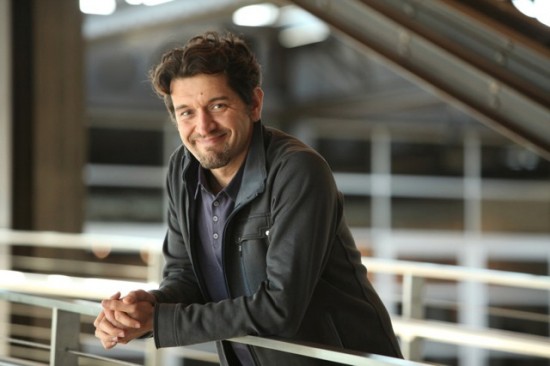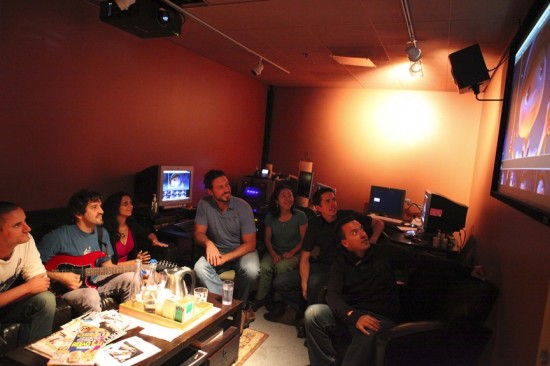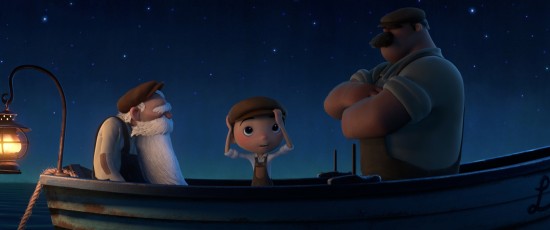Q&A: How Does A Pixar Short Film Get Made?
Over the years, we've learned a lot about how Pixar develops and produces their feature animated films, but we've learned very little about how the beloved short films get created. So I decided it was time we find out. I shot a message over to Enrico Casarosa, the director of Pixar's next short film La Luna, who was happy to shed some light on the process. "How Does A Pixar Short Film Get Made?" Find out, after the jump.
While most people won't get to see La Luna until its released in June 2012 attached to Brave, the short has been playing the film festival circuit and already short listed for the Best Animated Short Film Oscar. I was lucky enough to catch a screening of it at the 2011 Telluride Film Festival, and I loved it so much that they used my quote in their "For Your Consideration" advertisements.
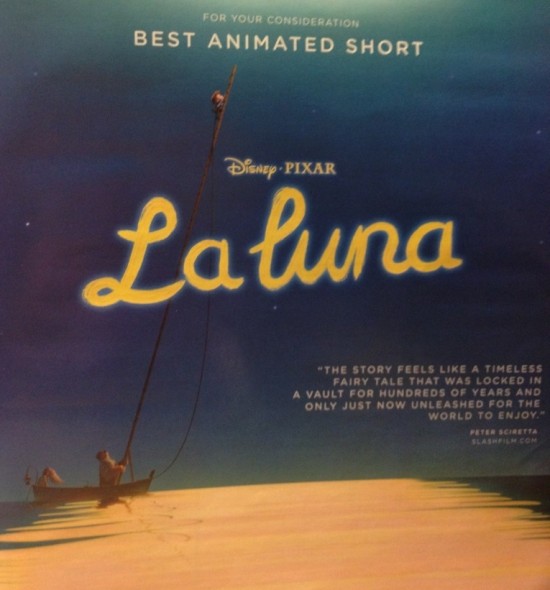 A Very Brief History of Pixar's Short FilmsPixar was not initially designed to be an animation studio. The company started out as a part of Lucasfilm's Computer Division, developing a image computer system which was primarily sold to government and medical agencies. Pixar's first short film, Luxo Jr. (a character which is featured in the studio logo shown before each film), was created in an effort to drive sales of the computer system. The rest is history, Steve Jobs led the company to produce the world's first computer animated feature film (Toy Story), and the company has gone on to gross over $7 billion at the worldwide box office, win 26 Academy Awards, 7 Golden Globes, and 3 Grammy Awards. Along the way, they've continued to produce short films — earning nine Academy Award nominations and three Best Animated Short Film Academy Awards.
A Very Brief History of Pixar's Short FilmsPixar was not initially designed to be an animation studio. The company started out as a part of Lucasfilm's Computer Division, developing a image computer system which was primarily sold to government and medical agencies. Pixar's first short film, Luxo Jr. (a character which is featured in the studio logo shown before each film), was created in an effort to drive sales of the computer system. The rest is history, Steve Jobs led the company to produce the world's first computer animated feature film (Toy Story), and the company has gone on to gross over $7 billion at the worldwide box office, win 26 Academy Awards, 7 Golden Globes, and 3 Grammy Awards. Along the way, they've continued to produce short films — earning nine Academy Award nominations and three Best Animated Short Film Academy Awards.
At first the short film program was used to help push the boundaries of the software, part of research and development. Today the short films are used more as a testing ground for new talent. For example, Mark Andrews was given his shot with the short One Man Band (nominated for an Oscar in 2005) and is now the director of Pixar's 2012 feature Brave. Casarosa joined Pixar on Ratatouille after working as a storyboard artist at Blue Sky Studios on the original Ice Age. He has since worked on Up, but La Luna is his first time in the "director's chair."
While the interview touches on La Luna, there are no spoilers, and the majority of the talk focuses on the process.
Question: Do they work on shorts at Pixar Canada?Enrico Casarosa: Not original shorts at the moment. They have been focusing on the franchise shorts right now, so that's the setup right now and even story is still at Pixar in Emeryville. Right now they are doing production work, so they start from layout on to finishing. The rest is still at Pixar, so...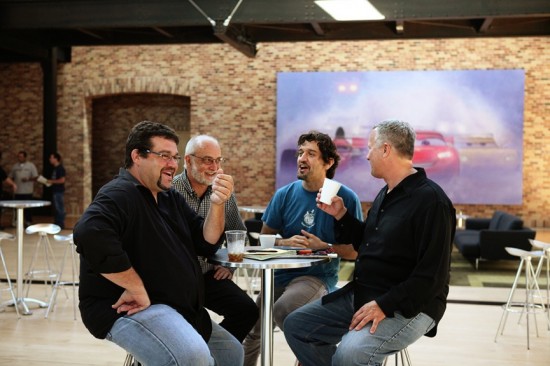
La Luna's producer Kevin Reher and production manager Aj Riebli with SupTech Daniel McCoy and Casarosa in the Pixar atrium.
Question: Your film was produced entirely in Emeryville?Enrico Casarosa: That's correct, yeah. Unless you want to count music. So a little bit down here [Los Angeles].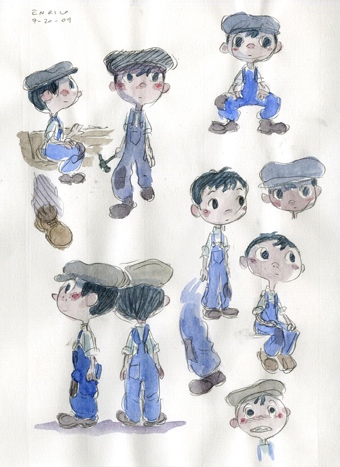 Question: How did you come up with the idea for LA LUNA?Enrico Casarosa: It's a little bit... The heart of it is certainly the memory of living with my dad and my grandfather and them not getting along and me kind of feeling stuck between one guy kind of talking to me and the other guy talking to me and they never really talked to each other. That uncomfortable-ness, I thought it would be interesting to kind of explore and also in a way of kind of saying "Well if you are a little kid, how can you find your own way when someone is telling you to do it that way or do it this way?" I thought that would be an interesting thing to have as a core of a kind of a bit of an emotional core. Then the fantastic side of this was kind of a little bit inspired by all of the things I love, Miyazaki or Saint-Exupery with his LITTLE PRINCE, you know the tiny little prince on the tiny little planet always fascinated me, the visuals of that. Then there's also Italo Calvino who's an author I always bring up, because he is a master. He is an Italian writer and he's written some books that are also popular here, like INVISIBLE CITIES and he has a lot of short stories that are very much about the mundane and the fantastic. So in a specific one of them he had people going to the moon and getting milk. They were milking the moon kind of and then even just A GRAND DAY OUT from Aardman Animation where it's made of cheese. They go and have cheese and crackers on the moon. I was always fascinated by these things, so I thought "I would love to come up with my own strange crazy myth about how the moon works or what's on the moon, what makes it glow, or what is it?" So that was a little bit the things that I thought would be fun to put together and I knew that I wanted them to have a job, you know a trait that the kid had to be kind of introduced to.
Question: How did you come up with the idea for LA LUNA?Enrico Casarosa: It's a little bit... The heart of it is certainly the memory of living with my dad and my grandfather and them not getting along and me kind of feeling stuck between one guy kind of talking to me and the other guy talking to me and they never really talked to each other. That uncomfortable-ness, I thought it would be interesting to kind of explore and also in a way of kind of saying "Well if you are a little kid, how can you find your own way when someone is telling you to do it that way or do it this way?" I thought that would be an interesting thing to have as a core of a kind of a bit of an emotional core. Then the fantastic side of this was kind of a little bit inspired by all of the things I love, Miyazaki or Saint-Exupery with his LITTLE PRINCE, you know the tiny little prince on the tiny little planet always fascinated me, the visuals of that. Then there's also Italo Calvino who's an author I always bring up, because he is a master. He is an Italian writer and he's written some books that are also popular here, like INVISIBLE CITIES and he has a lot of short stories that are very much about the mundane and the fantastic. So in a specific one of them he had people going to the moon and getting milk. They were milking the moon kind of and then even just A GRAND DAY OUT from Aardman Animation where it's made of cheese. They go and have cheese and crackers on the moon. I was always fascinated by these things, so I thought "I would love to come up with my own strange crazy myth about how the moon works or what's on the moon, what makes it glow, or what is it?" So that was a little bit the things that I thought would be fun to put together and I knew that I wanted them to have a job, you know a trait that the kid had to be kind of introduced to.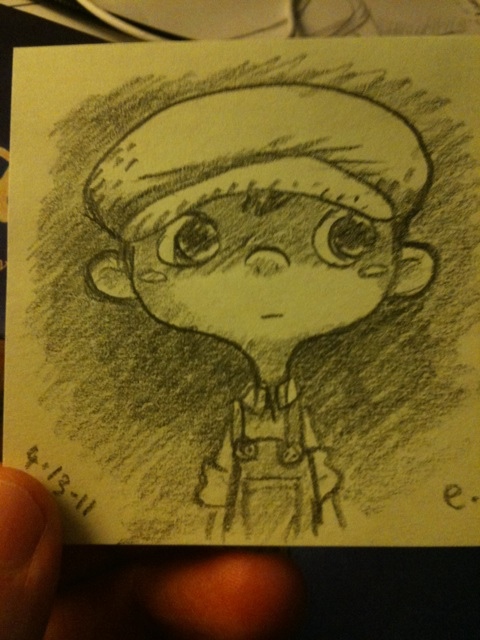 Question: What is the process of going in and pitching this idea? Is there an event every year where employees go in and pitch short ideas? How does that work?Enrico Casarosa: They don't. Yeah, some studios do. I've participated in one at Blue Sky that was called "Pitchfest." At Pixar it's a little more informal. You kind of go like "Hey, could I pitch something?" And they are like "Yes, this is not a bad time. Go for it." I think it's luckily a studio where they really value your ideas. Now probably the fact that I was there for a few years and they new me certainly doesn't hurt. So then when you have to pitch you have to pitch three ideas just like for features. The feature directors are doing the same kind of process. You pitch three ideas in front of John Lasseter and Ed Catmull and Jim Morris. They are kind of the three heads of...
Question: What is the process of going in and pitching this idea? Is there an event every year where employees go in and pitch short ideas? How does that work?Enrico Casarosa: They don't. Yeah, some studios do. I've participated in one at Blue Sky that was called "Pitchfest." At Pixar it's a little more informal. You kind of go like "Hey, could I pitch something?" And they are like "Yes, this is not a bad time. Go for it." I think it's luckily a studio where they really value your ideas. Now probably the fact that I was there for a few years and they new me certainly doesn't hurt. So then when you have to pitch you have to pitch three ideas just like for features. The feature directors are doing the same kind of process. You pitch three ideas in front of John Lasseter and Ed Catmull and Jim Morris. They are kind of the three heads of...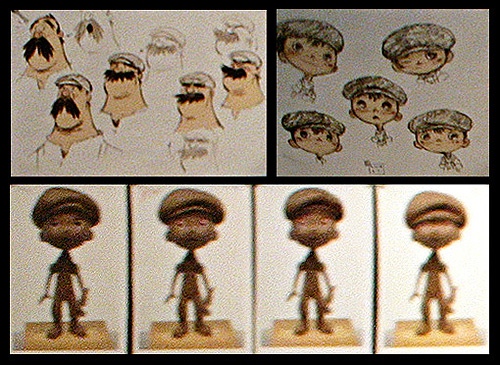 Question: ...The brain trust?Enrico Casarosa: Well they're not... It's an interesting thing. The shorts are slightly more in the hands of John. He is the executive producer on them. The brain trust does come a tiny bit into play when you are more making it and we pulled it into play as much as we could, because we wanted to get people's feedback. The great thing about the brain trust is you have different people, so John has great feedback, but you want somebody else's eyes on it too. But for the shorts, he very much loves them and he loves to mentor people through and it's really him that will give you the green light. So I pitched the three ideas and it's a little bit of a dog and pony show. I pitched through one and one I did with cards and you act out and you just try and give your best show that you can.
Question: ...The brain trust?Enrico Casarosa: Well they're not... It's an interesting thing. The shorts are slightly more in the hands of John. He is the executive producer on them. The brain trust does come a tiny bit into play when you are more making it and we pulled it into play as much as we could, because we wanted to get people's feedback. The great thing about the brain trust is you have different people, so John has great feedback, but you want somebody else's eyes on it too. But for the shorts, he very much loves them and he loves to mentor people through and it's really him that will give you the green light. So I pitched the three ideas and it's a little bit of a dog and pony show. I pitched through one and one I did with cards and you act out and you just try and give your best show that you can.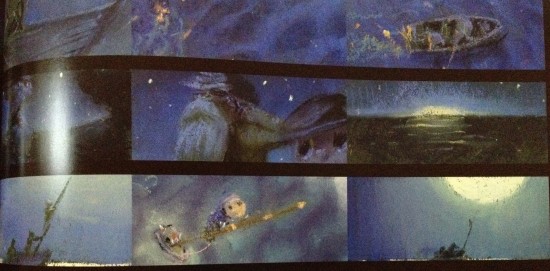 Question: So you brought in some art and showed them?Enrico Casarosa: Yes, I did a lot of drawings. I should mention that. I did maybe 30 images for LA LUNA in watercolor and pencil that then ended up being our main skeleton of the story. I did probably another 15 or 20 images for a second idea just to mix up. One I did more on boards to mix it up and a third one was even simpler, it was just a couple of boards with images and inspirational stuff with some drawings and some photos. So it really varies a little bit from person to person, but what you want to do it to still give an idea of the potential, but it doesn't have to be fully and completely realized. You don't want to do story reels. It just doesn't make sense, because there's a process of sculpting it and making it. It needs its time.
Question: So you brought in some art and showed them?Enrico Casarosa: Yes, I did a lot of drawings. I should mention that. I did maybe 30 images for LA LUNA in watercolor and pencil that then ended up being our main skeleton of the story. I did probably another 15 or 20 images for a second idea just to mix up. One I did more on boards to mix it up and a third one was even simpler, it was just a couple of boards with images and inspirational stuff with some drawings and some photos. So it really varies a little bit from person to person, but what you want to do it to still give an idea of the potential, but it doesn't have to be fully and completely realized. You don't want to do story reels. It just doesn't make sense, because there's a process of sculpting it and making it. It needs its time.
Due to the amount of graphics and images included in this edition of Q&A, we have to split this post over a FEW of pages. Click the link above to continue the second page of Q&A.
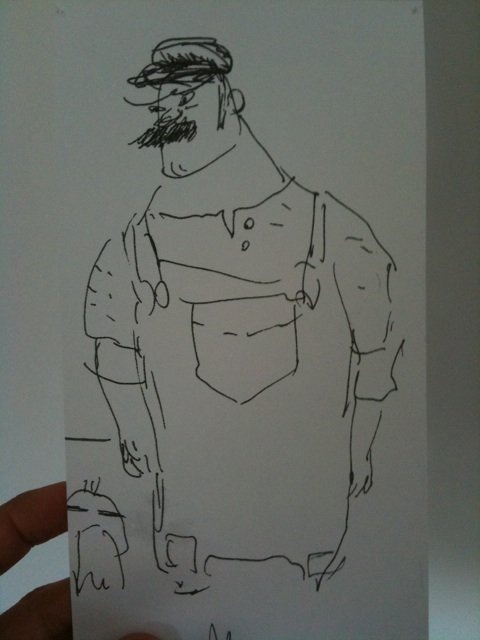 Question: So how long ago was that pitch? How long is this process from the pitch to it being finished?Enrico Casarosa: It can really vary, because then we waited for a while for there to be the right timing for production. What happens is there's a lot of big peaks into production where everybody is really busy because of the features, so you have to go and get the valley when you can have some people to make a short, because otherwise there's nobody. So you are kind of the last guy that gets to say "Hey, could we have a couple of people for this?"
Question: So how long ago was that pitch? How long is this process from the pitch to it being finished?Enrico Casarosa: It can really vary, because then we waited for a while for there to be the right timing for production. What happens is there's a lot of big peaks into production where everybody is really busy because of the features, so you have to go and get the valley when you can have some people to make a short, because otherwise there's nobody. So you are kind of the last guy that gets to say "Hey, could we have a couple of people for this?"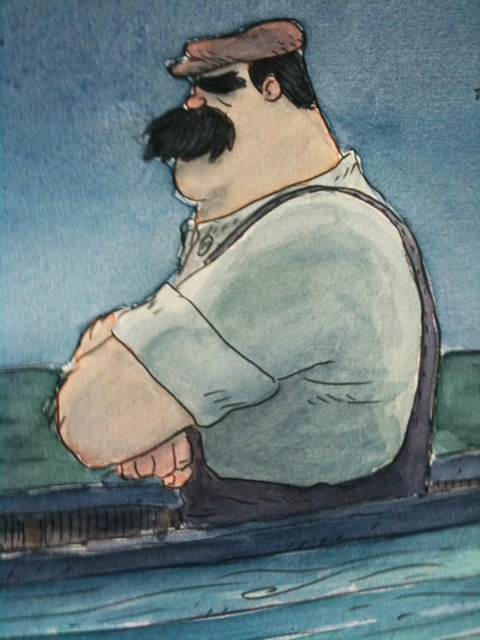 Question: So it's not a dedicated short team, you are using some of the people that are working on the feature, but when they're not needed?Enrico Casarosa: Yeah, absolutely. So staffing... You need a good producer on this, because it's juggling and you are last in the pecking order. It's an interesting thing. You have to do with a little less, but it's part of what's fun. You have a small team. You are like "Let's do this!" You are hands on and doing a little more. Everybody has to do a little more, because of that. But timing-wise let's say if you don't consider that time where I was actually kind of a little bit waiting. I was still working on another movie, but in the meanwhile doing a little storyboards, but I had pitched in February 2009. I think I started off actually being full time in October, so that was just waiting. For me it was roughly a year and the team for the full production, because at first it was only me and then I would say for production it was roughly eight to nine months. Then it's a little bit kind of a mix, because we were all done, but then we didn't get the music for another three or four months. It can be a little tricky to tell.
Question: So it's not a dedicated short team, you are using some of the people that are working on the feature, but when they're not needed?Enrico Casarosa: Yeah, absolutely. So staffing... You need a good producer on this, because it's juggling and you are last in the pecking order. It's an interesting thing. You have to do with a little less, but it's part of what's fun. You have a small team. You are like "Let's do this!" You are hands on and doing a little more. Everybody has to do a little more, because of that. But timing-wise let's say if you don't consider that time where I was actually kind of a little bit waiting. I was still working on another movie, but in the meanwhile doing a little storyboards, but I had pitched in February 2009. I think I started off actually being full time in October, so that was just waiting. For me it was roughly a year and the team for the full production, because at first it was only me and then I would say for production it was roughly eight to nine months. Then it's a little bit kind of a mix, because we were all done, but then we didn't get the music for another three or four months. It can be a little tricky to tell.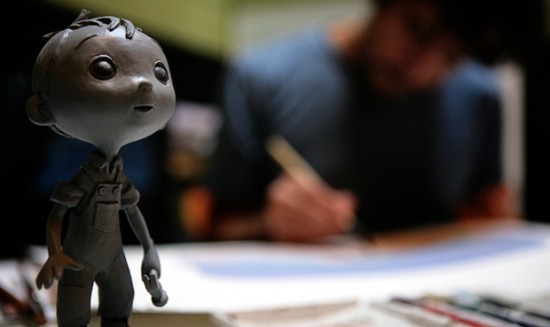 Question: How many artists and animators work on a short compared to a feature?Enrico Casarosa: We had, for example, ten animators. In art [dept] it was such a different thing, because we would get one person for two weeks and you would go "Help me design the characters." So I mean I designed the characters, but then I wanted someone to kind of come in and kind of add to it and make them a little more three-dimensional. I do art, but it's a little bit 2D and so you would be able to steal people for one week, two weeks, three weeks. There were like ten lighters... Animation and lighting are probably the biggest teams you are dealing with. Layout, one guy laid it all out. I mean in the middle of production probably the most you would find on the short would be 30 or so people. The biggest crew we had was when animation was finishing and lighting was starting. That's kind of the biggest.
Question: How many artists and animators work on a short compared to a feature?Enrico Casarosa: We had, for example, ten animators. In art [dept] it was such a different thing, because we would get one person for two weeks and you would go "Help me design the characters." So I mean I designed the characters, but then I wanted someone to kind of come in and kind of add to it and make them a little more three-dimensional. I do art, but it's a little bit 2D and so you would be able to steal people for one week, two weeks, three weeks. There were like ten lighters... Animation and lighting are probably the biggest teams you are dealing with. Layout, one guy laid it all out. I mean in the middle of production probably the most you would find on the short would be 30 or so people. The biggest crew we had was when animation was finishing and lighting was starting. That's kind of the biggest.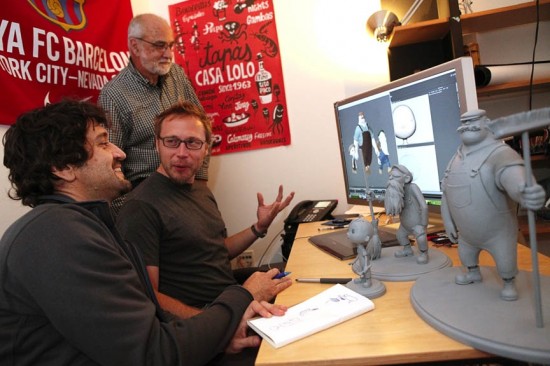 Question: What is that compared to like a feature at Pixar?Enrico Casarosa: Oh man, that's got to be at least 400 or 500 people I would think.Question: I think everybody knows a lot about the feature process and that's why I wanted to talk to you about the short process, because we know that it's like four or five years of development with the feature and they remake it four or five times. Nine months of production is a lot shorter of a process. So are you remaking the story over and over again like the features, or is the development different?Enrico Casarosa: Yeah, there's a tiny bit of that. For LA LUNA it didn't... Well here's the other thing, the story team was me. I didn't have to communicate what I want since I'm a story artist and I boarded the whole thing. I mean, that's how I wrote it. I didn't really sit down and write a script, I just drew it and that's what was wonderful.
Question: What is that compared to like a feature at Pixar?Enrico Casarosa: Oh man, that's got to be at least 400 or 500 people I would think.Question: I think everybody knows a lot about the feature process and that's why I wanted to talk to you about the short process, because we know that it's like four or five years of development with the feature and they remake it four or five times. Nine months of production is a lot shorter of a process. So are you remaking the story over and over again like the features, or is the development different?Enrico Casarosa: Yeah, there's a tiny bit of that. For LA LUNA it didn't... Well here's the other thing, the story team was me. I didn't have to communicate what I want since I'm a story artist and I boarded the whole thing. I mean, that's how I wrote it. I didn't really sit down and write a script, I just drew it and that's what was wonderful.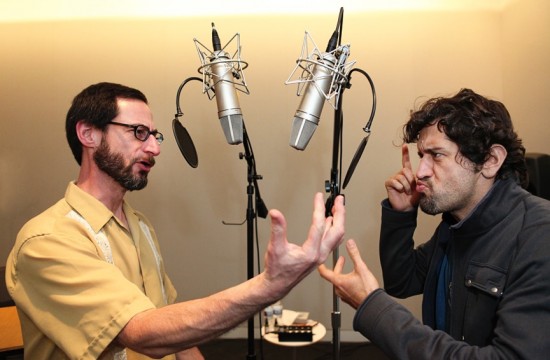 Question: So with that, you put the boards on a wall?Enrico Casarosa: No, we storyboard just like in the feature. We storyboard right now on tablets a lot. And we then put it in a story reel with scratch voices. Me and the editor were dad and grandpa and that I think gave us a little bit of promise, because at first John Lasseter didn't want the gibberish. He wasn't in love with the gibberish, like "That's annoying" and I was like "Well that's because it's me and the editor"[Both Laugh]Enrico Casarosa: But that took us a while to find the right flavor... I wanted a little bit of the gesticulating with the gibberish, so I fought for it and I'm glad we made it. So you work with an editor, so I give him the boards and he puts them all in timing and he puts even temp music. We put the whole thing out and at a certain point you get an "Okay, you're locked for production," which means "Your story reel is what it needs to be. You can start going to layout." In the meanwhile, you've built your characters and your sets and then you really start setting camera in the 3D world. So the process was a little smoother.
Question: So with that, you put the boards on a wall?Enrico Casarosa: No, we storyboard just like in the feature. We storyboard right now on tablets a lot. And we then put it in a story reel with scratch voices. Me and the editor were dad and grandpa and that I think gave us a little bit of promise, because at first John Lasseter didn't want the gibberish. He wasn't in love with the gibberish, like "That's annoying" and I was like "Well that's because it's me and the editor"[Both Laugh]Enrico Casarosa: But that took us a while to find the right flavor... I wanted a little bit of the gesticulating with the gibberish, so I fought for it and I'm glad we made it. So you work with an editor, so I give him the boards and he puts them all in timing and he puts even temp music. We put the whole thing out and at a certain point you get an "Okay, you're locked for production," which means "Your story reel is what it needs to be. You can start going to layout." In the meanwhile, you've built your characters and your sets and then you really start setting camera in the 3D world. So the process was a little smoother.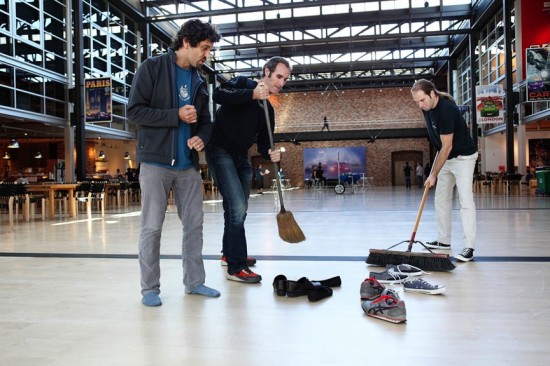
Animators Juan Carlos Navarro and Javier Moya record themselves sweeping to help capture the right movement.
Question Along that process how many times do you meet with the Pixar brain trust and show them what you have?Enrico Casarosa: Good question. I think with John we probably met two times... By the third time he was like "Alright, go with this." Or maybe it was the fourth if you count the first time. So you are showing him the reels, showing a little bit of your art, you get some notes, in the meanwhile you are making characters and you are kind of figuring it out.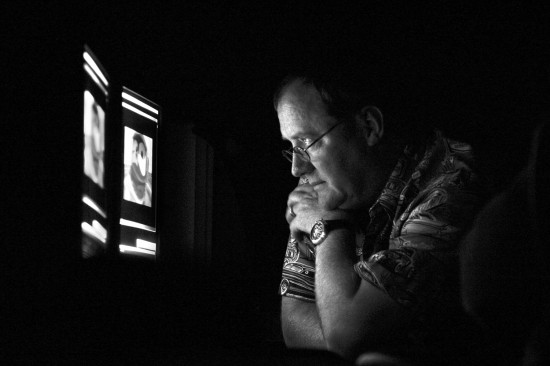 Question: Do you have an example of something that John might have suggested that changed your film?Enrico Casarosa: Yeah, he had one great suggestion to begin with. He had several. He's very, very sharp. I think like ninety percent of the stuff he suggested to us we loved and ten percent we agreed maybe we would change it, but not with the solutions, so we found our own solution. One great suggestion he said was like "This should be the boy's first day. He's never been here." In my first pitch it wasn't quite clear and I thought "That's great." I immediately embraced that, because as an audience now we are in the boy's shoes. We are just like "What is happening? What's going on?" So that really made it really, really great. Andrew Stanton saw it pretty early on and he was like "This is great." He loved it right away and he's like "Well you know you should have them fight a little more even in the beginning" and I was like "Okay..." and that's when we figured out the hats for example, so I mean not everyone was already there. You start putting all of these things that feel right. There are suggestions and you kind of pick and choose. I have another interesting example, we showed it to Brad Bird and he did not... This is a spoiler (invisotext – highlight white area to reveal), but he did not understand that they had never seen a big star, when this huge star lands. It wasn't clear in the story reels. I thought that the pantomime of like "Have you seen anything like this before?" would help and certainly could sell it, but his suggestion was for example for them to look at a manual and be like "It's not in the manual." I didn't like the idea of the manual, but I liked the idea of trying to strengthen this, so we put some broken tools on the ground after we cut. We were trying to strengthen the idea like they are trying to do something, they don't know what to do with this. So there are these interesting areas where you get a note with a solution and you don't like the solution, so you have to find your own solution. Probably the note is good, but the solution might not fit your sensibilities. That was an interesting one.
Question: Do you have an example of something that John might have suggested that changed your film?Enrico Casarosa: Yeah, he had one great suggestion to begin with. He had several. He's very, very sharp. I think like ninety percent of the stuff he suggested to us we loved and ten percent we agreed maybe we would change it, but not with the solutions, so we found our own solution. One great suggestion he said was like "This should be the boy's first day. He's never been here." In my first pitch it wasn't quite clear and I thought "That's great." I immediately embraced that, because as an audience now we are in the boy's shoes. We are just like "What is happening? What's going on?" So that really made it really, really great. Andrew Stanton saw it pretty early on and he was like "This is great." He loved it right away and he's like "Well you know you should have them fight a little more even in the beginning" and I was like "Okay..." and that's when we figured out the hats for example, so I mean not everyone was already there. You start putting all of these things that feel right. There are suggestions and you kind of pick and choose. I have another interesting example, we showed it to Brad Bird and he did not... This is a spoiler (invisotext – highlight white area to reveal), but he did not understand that they had never seen a big star, when this huge star lands. It wasn't clear in the story reels. I thought that the pantomime of like "Have you seen anything like this before?" would help and certainly could sell it, but his suggestion was for example for them to look at a manual and be like "It's not in the manual." I didn't like the idea of the manual, but I liked the idea of trying to strengthen this, so we put some broken tools on the ground after we cut. We were trying to strengthen the idea like they are trying to do something, they don't know what to do with this. So there are these interesting areas where you get a note with a solution and you don't like the solution, so you have to find your own solution. Probably the note is good, but the solution might not fit your sensibilities. That was an interesting one.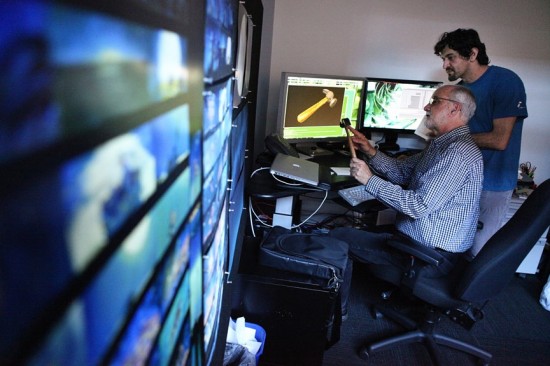 Question: It's pointing out something that needs works, but maybe the solution...Enrico Casarosa: Yeah.Question: One thing I love about the short is it feels classic, like I said in the review, but also it feels like the most personal Pixar short that has been released. Usually they are fun, but this seems personal. Even the name, it's not in English and the film is 6 minutes and 51 seconds — the longest Pixar short in the history of Pixar, so are any of those things battles?Enrico Casarosa: The personal side wasn't and I was so happy to see them completely embracing the flavor, the Italian flavor, and the personal side. I think we make features thinking about those connections and knowing that a director needs to find these connections to his stories. That's really important, that's what gives it heart. So I was very, very happy to see them completely embrace that. There were some battles, but there was never a battle about the title. The title was there right at first, because it just seemed right and I was just surprised actually that it legally cleared. It wasn't a problem. There are some shorts with similar... Actually there was a short named LUNA, but we didn't know about that. The only battle was the length, because we kind of tried just out of budgetary reasons they tell you "Let's make a four and a half minute short" and our reels were four and a half minutes, but I knew that I wanted to let it breath more, so what we slowly did is get our space slightly and give room to breath to every shot that it needed and I think because we did it carefully and with the same budget it flew. If I was at first to say "No, I want to make a six minute fifty one" they would have said, "You are crazy. We are going to go over budget," but luckily because they are long shots, so in production if you have a high shot count it's expensive, but we had a long short, but a low shot count. So that really helped us and the fact that I think we slowly did it and we made it all work, that was nice that it worked out.Question: The Pixar shorts program was started to give a chance for someone who hasn't directed to direct, but also to advance the technologies in certain ways.Enrico Casarosa: Yeah.
Question: It's pointing out something that needs works, but maybe the solution...Enrico Casarosa: Yeah.Question: One thing I love about the short is it feels classic, like I said in the review, but also it feels like the most personal Pixar short that has been released. Usually they are fun, but this seems personal. Even the name, it's not in English and the film is 6 minutes and 51 seconds — the longest Pixar short in the history of Pixar, so are any of those things battles?Enrico Casarosa: The personal side wasn't and I was so happy to see them completely embracing the flavor, the Italian flavor, and the personal side. I think we make features thinking about those connections and knowing that a director needs to find these connections to his stories. That's really important, that's what gives it heart. So I was very, very happy to see them completely embrace that. There were some battles, but there was never a battle about the title. The title was there right at first, because it just seemed right and I was just surprised actually that it legally cleared. It wasn't a problem. There are some shorts with similar... Actually there was a short named LUNA, but we didn't know about that. The only battle was the length, because we kind of tried just out of budgetary reasons they tell you "Let's make a four and a half minute short" and our reels were four and a half minutes, but I knew that I wanted to let it breath more, so what we slowly did is get our space slightly and give room to breath to every shot that it needed and I think because we did it carefully and with the same budget it flew. If I was at first to say "No, I want to make a six minute fifty one" they would have said, "You are crazy. We are going to go over budget," but luckily because they are long shots, so in production if you have a high shot count it's expensive, but we had a long short, but a low shot count. So that really helped us and the fact that I think we slowly did it and we made it all work, that was nice that it worked out.Question: The Pixar shorts program was started to give a chance for someone who hasn't directed to direct, but also to advance the technologies in certain ways.Enrico Casarosa: Yeah.
Click the link above to continue the third and final page of Q&A.
Working in lighting department, Enrico found "finaling" a shot with a guitar riff, accompanied by a loud "F$#% YEAH!!!" to be the most effective and satisfying way to final something.
Question: Does this film advance any technologies?Enrico Casarosa: Not specifically. We kind of tried... We were kind of given TS3 technology which it wasn't even brave. In fact a couple of times we wished we had some brave technology, on the hair especially. That hair was a little difficult, because we wanted moving hair. We were kind of asked to... It hasn't been as much a place where to do R and D just because it's not a place where they want to put a whole lot of expense. So our way was like "How can we get a different look with what we have?" I really pushed for scanning a lot of real materials like pastels and water colors, so we really achieved a look that I hope feels different and I think it's different through using way more media and kind of scanning it and putting it into the background, putting them on the textures on the characters, on the objects, but we didn't necessarily introduce new technology.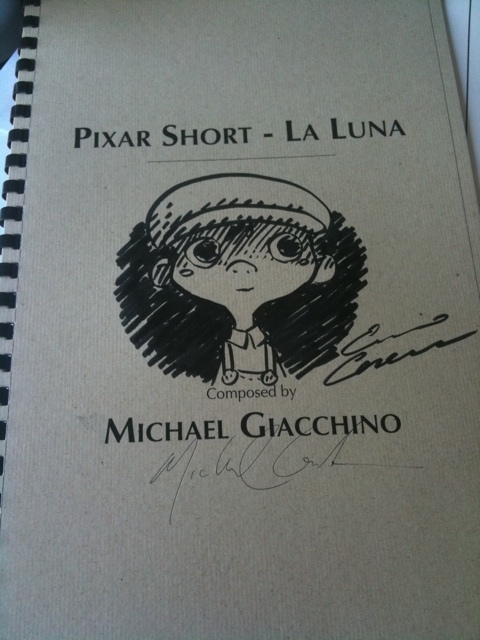 Question: Is [Michael] Giacchino part of the deal? Was he your choice or is it like "He's available for any Pixar..."Enrico Casarosa: Well you know at first we weren't even sure we could afford him, because again you are kind of trying to do things on a little independent short here and then John kept on with "I know an Italian guy that could do a pretty good job here..."[Both Laugh]Enrico Casarosa: I was like, "Well you know you're right." Then when we did end up working with him... We showed him the short and he was like "I want to do it" and so it was so great that he was so committed to doing it. I mean he's done a ton of our shorts, almost everyone of the latest shorts, but I kind of bombarded him with the music that was in our scratch score and the music that I was listening to which was a lot of Nino Rota from Fellini movies like AMARCORD and 8 ½ and some folk Italian music and he was so game. I think some composers might not feel so great about just being told "Hey, this is what we are looking for," but this was kind of more like "I hope you can kind of let this flow through your veins and see what comes." He wanted to reach for his roots. His parents still speak Italian, so he's I guess first or second generation you would call it. He was telling me his little town, whenever he goes back the Mayor wants to see him and it's a big deal. He's a storyteller. I almost feel he's more of a storyteller than a musician at his heart.
Question: Is [Michael] Giacchino part of the deal? Was he your choice or is it like "He's available for any Pixar..."Enrico Casarosa: Well you know at first we weren't even sure we could afford him, because again you are kind of trying to do things on a little independent short here and then John kept on with "I know an Italian guy that could do a pretty good job here..."[Both Laugh]Enrico Casarosa: I was like, "Well you know you're right." Then when we did end up working with him... We showed him the short and he was like "I want to do it" and so it was so great that he was so committed to doing it. I mean he's done a ton of our shorts, almost everyone of the latest shorts, but I kind of bombarded him with the music that was in our scratch score and the music that I was listening to which was a lot of Nino Rota from Fellini movies like AMARCORD and 8 ½ and some folk Italian music and he was so game. I think some composers might not feel so great about just being told "Hey, this is what we are looking for," but this was kind of more like "I hope you can kind of let this flow through your veins and see what comes." He wanted to reach for his roots. His parents still speak Italian, so he's I guess first or second generation you would call it. He was telling me his little town, whenever he goes back the Mayor wants to see him and it's a big deal. He's a storyteller. I almost feel he's more of a storyteller than a musician at his heart.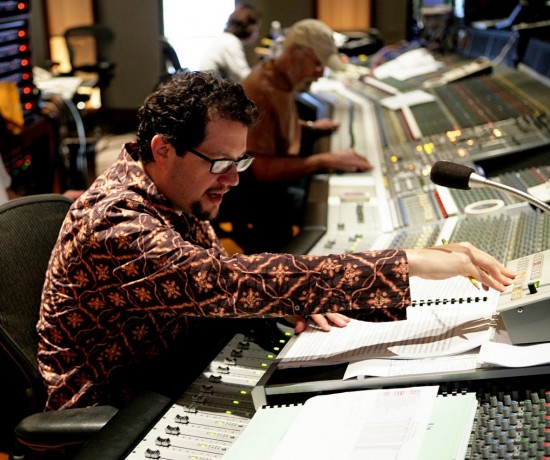 Question: I think he's going to direct some day. I feel like he will.Enrico Casarosa: Yeah, he's got it in him you know? That is a willingness to sacrifice anything for the right emotion in the moment. I mean when you communicate to a composer all you're talking about honestly is emotion and he was so great at that.
Question: I think he's going to direct some day. I feel like he will.Enrico Casarosa: Yeah, he's got it in him you know? That is a willingness to sacrifice anything for the right emotion in the moment. I mean when you communicate to a composer all you're talking about honestly is emotion and he was so great at that.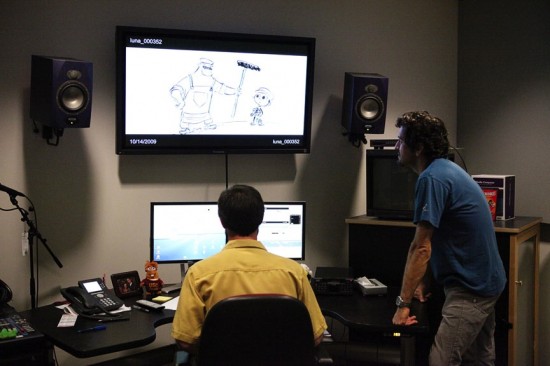 Question: How long did you have to work with him on a short like this?Enrico Casarosa: Very quick. It's amazing how quick it is. Again in the spirit of making things quick and cheap, we ponied up on the CARS 2 score, so we get the last 45 minutes of the orchestra and in 45 minutes we got a great score. It's amazing. And we worked with him for two or three weeks, but he's one busy guy... I mean he probably worked just a few days. He's very, very quick and that's what's great. (Laughs) I still remember this, I was on the phone with him and was like "What do you think..." I was giving him some notes on the temp score he gave us and I'm like "You know what? Here I was just feeling this and that" and he said "Oh, wait." (Makes musical melody) "More like this?" and I'm on my cell phone and I'm like "I think so, yeah." It's just so great that he's actually changing it on the spot as you are listening to it. He's coming from TV I think that made him so "Go! Go! Go!" and no ego. We were toning down a little bit the mandolin. I had moments where I didn't want to orchestration to feel in any way cliché, and he was like "You want the mandolin out? I could take it all out." I was like "No, no just a little... More like pepper not like garlic in Italian food." (Laughs) It was fun.
Question: How long did you have to work with him on a short like this?Enrico Casarosa: Very quick. It's amazing how quick it is. Again in the spirit of making things quick and cheap, we ponied up on the CARS 2 score, so we get the last 45 minutes of the orchestra and in 45 minutes we got a great score. It's amazing. And we worked with him for two or three weeks, but he's one busy guy... I mean he probably worked just a few days. He's very, very quick and that's what's great. (Laughs) I still remember this, I was on the phone with him and was like "What do you think..." I was giving him some notes on the temp score he gave us and I'm like "You know what? Here I was just feeling this and that" and he said "Oh, wait." (Makes musical melody) "More like this?" and I'm on my cell phone and I'm like "I think so, yeah." It's just so great that he's actually changing it on the spot as you are listening to it. He's coming from TV I think that made him so "Go! Go! Go!" and no ego. We were toning down a little bit the mandolin. I had moments where I didn't want to orchestration to feel in any way cliché, and he was like "You want the mandolin out? I could take it all out." I was like "No, no just a little... More like pepper not like garlic in Italian food." (Laughs) It was fun.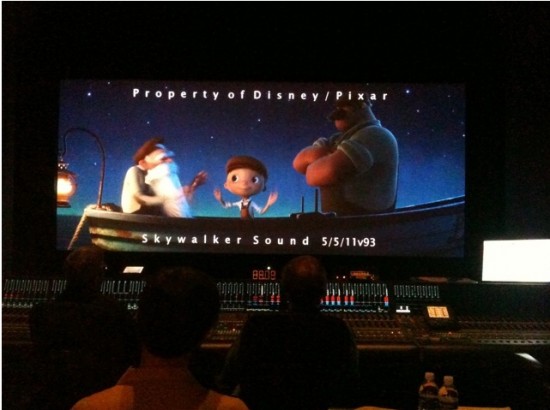 Question: How early does 3D become part of the process?Enrico Casarosa: We started pretty early. On the first few shots that we had lit we started doing tests, so it was actually pretty early. You think about it when you start planning your camera, which is in layout. You know, we think about camera just like "Okay, how should the camera support your story?" For our movie for example it was like "Get a little more depth when you are on this new world. Stay a little flatter with your lenses when you are on the sea." So it's usually about getting the contrast you want for your story. Stereo is the same way. I used it very much the same way. I wanted a little more depth in some moments, and others I wanted a little flatter. I embraced it because there was something cool that I liked at first. It felt like I was looking at a diorama in an old viewfinder. My short wants to feel a little bit old, I thought it would be the 1920's and 30's. I thought I would love to see this in 3D with a little weird viewfinder old projector effect over it (Makes old film projector noises.) So I kind of embraced it that way and we avoided getting very much in front of the camera, because this is not really a short that would support that. Then there's good contrast when you need towards the end without giving too many spoilers. That's a cool thing about 3D you know. I don't love how we lose saturation. We really looked for nice, beautiful saturated blues and yellows. So the stereo gets you this beautiful new depth when you want it, but if I had to choose I would probably go for the other one, but they are so different. They give you different feels, so it's kind of fun to watch them both.
Question: How early does 3D become part of the process?Enrico Casarosa: We started pretty early. On the first few shots that we had lit we started doing tests, so it was actually pretty early. You think about it when you start planning your camera, which is in layout. You know, we think about camera just like "Okay, how should the camera support your story?" For our movie for example it was like "Get a little more depth when you are on this new world. Stay a little flatter with your lenses when you are on the sea." So it's usually about getting the contrast you want for your story. Stereo is the same way. I used it very much the same way. I wanted a little more depth in some moments, and others I wanted a little flatter. I embraced it because there was something cool that I liked at first. It felt like I was looking at a diorama in an old viewfinder. My short wants to feel a little bit old, I thought it would be the 1920's and 30's. I thought I would love to see this in 3D with a little weird viewfinder old projector effect over it (Makes old film projector noises.) So I kind of embraced it that way and we avoided getting very much in front of the camera, because this is not really a short that would support that. Then there's good contrast when you need towards the end without giving too many spoilers. That's a cool thing about 3D you know. I don't love how we lose saturation. We really looked for nice, beautiful saturated blues and yellows. So the stereo gets you this beautiful new depth when you want it, but if I had to choose I would probably go for the other one, but they are so different. They give you different feels, so it's kind of fun to watch them both.
Question: The film's been done for a while, right? I mean I saw it in Telluride.Enrico Casarosa: Yeah, we finished it in the spring of this year [2011].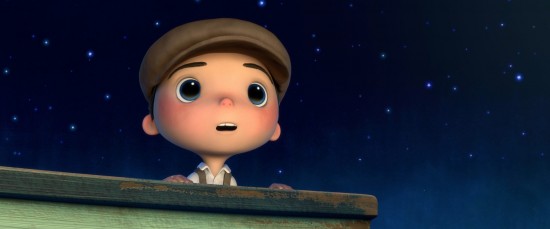 Question: So why wasn't this on CARS 2? Did it just happen that way?Enrico Casarosa: They already had HAWAIIAN VACATION. We finished HAWAIIAN VACATION and then we finished LA LUNA. And HAWAIIAN VACATION was scheduled to go with CARS 2, so there was going to be a little bit of shelf time, but then Pete Docter said, "Why don't you just put it out?" I was very thankful because I was a little bummed out. So it seemed to make sense. It was about time. It was done so much earlier and it's been great to have it have it's own little spotlight.
Question: So why wasn't this on CARS 2? Did it just happen that way?Enrico Casarosa: They already had HAWAIIAN VACATION. We finished HAWAIIAN VACATION and then we finished LA LUNA. And HAWAIIAN VACATION was scheduled to go with CARS 2, so there was going to be a little bit of shelf time, but then Pete Docter said, "Why don't you just put it out?" I was very thankful because I was a little bummed out. So it seemed to make sense. It was about time. It was done so much earlier and it's been great to have it have it's own little spotlight.
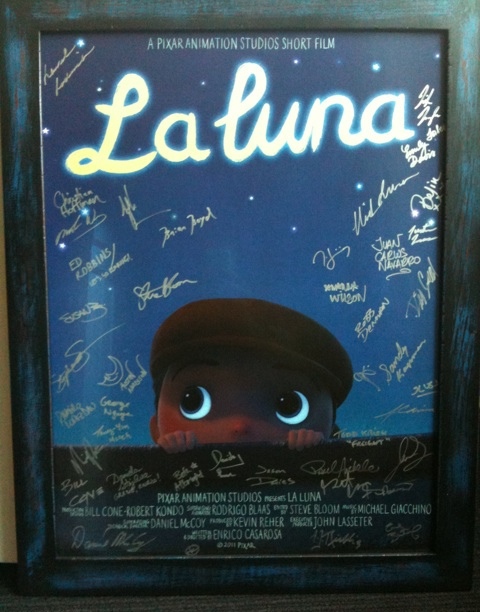
Question: Well I can't wait for everybody else to see and I thank you very much.Enrico Casarosa: I know. Oh, thank you. It's been a pleasure.Watch a clip from La Luna below:

